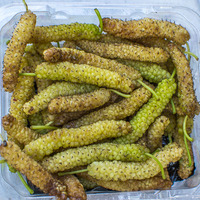Common name: White mulberry
Other common names: Mulberry tree, Mulberry bush, Mulberry, Silkworm mulberry, Silkworm tree, Chinese white mulberry, White fruited mulberry
Description
White mulberry is a fruit tree originating from China. Exceptional specimens may reach heights of up to 20 m (65 ft), though it is more typically a small tree 9 to 12 m (30 to 40 ft) tall and develops a straight trunk supporting a pyramidal or rounded crown of gently weeping branches. The bark is light grey, smooth becoming fissured on older trees.
As a result of selective breeding over many years, it comes in a range of cultivars, with variation in fruit size, shape and colour, plant size, including dwarf forms and with different heat and cold tolerances.
The leaves are medium-sized, light glossy green and come in two forms, even on the same tree, either oval with smooth margins or palmate and deeply lobed. They are densely arranged in an alternate pattern along the stems and are deciduous, falling off the tree during seasonally dry or cool weather.
The new leaves emerge in spring, along with tiny, greenish-white female and male flowers held in separate, finger-like clusters arising at nodes along the branches. The fertilised female flowers are followed by small, elongated raspberry-like fruit that ripen in summer to dark purple, red, pink or green-white, depending on the variety.
Use
Under favourable growing conditions, the fruit ripen sufficiently and become sweet and flavoursome, reminding of cantaloupe or rockmelon. They are mainly eaten fresh out-of-hand or are made into jam soon after harvesting, as they deteriorate quickly. They can also be made into wine and when dried have a sweet, raisin-like taste.
It is commonly grown as an ornamental shade or landscape tree for its shapely form and dense, green foliage but only fruitless varieties are selected for planting because they present less of a litter and weed problem..
The leaves have a long history of use as food for silkworms and are also a valuable livestock feed, fed mainly to goats and cattle. They have a high crude protein content, the equivalent of around 15% of their dry weight.
The wood is fine-grained and medium-weight, averaging out at around 750 kilograms per cubic meter (47 lbs per cubic ft), but has low natural resistance to decay and the logs are of a small diameter, making sawing them into planks impractical. It is mostly used in its roundwood form, mainly for carving into sporting articles, such as hockey sticks and bats, for which it is well-suited due to its strength and flexibility properties. It also makes an excellent firewood when properly dried.
Health use
The leaves are one of the main sources of chlorophyll for the pharmaceutical and food industries, extracted for use in cosmetics, toiletries, such as toothpaste and as a natural colouring agent, especially in foods that do not require heat treatment, such as chilled desserts. Chlorophyll is also high in Vitamin K and is widely promoted as a blood and liver tonic.
Climate
Although naturally adapted to warm-temperate climates, White mulberry grows and fruits well in moderately humid subtropical and tropical climates, generally areas with annual lows of 10 to 25°C, annual highs of 19 to 36°C, annual rainfall of 300 to 2200 mm and a dry season of 3 to 8 months, extending to 12 months with irrigation or groundwater.
White mulberry is also grown in humid tropical lowland climates to produce leaves for feeding to livestock, but this is usually at the expense of fruit production, due to the susceptibility of the fruit to fungal disease brought on by hot, humid conditions.
Growing
New plants are usually raised from one-year-old hardwood cuttings. White mulberry performs best on rich, free-draining clay and loam soils of a moderately acid to slightly alkaline nature, generally with a pH of 6.0 to 7.5, and on sites with full to partial sun exposure. It is susceptible to wind damage and should not be planted on sites exposed to strong winds.
Problem features
Birds are attracted to the fruit and carry the seed afar, which has caused it to escape cultivation. As a result of widespread introduction, it has naturalised in many countries outside of its native range and is recorded as a weed of agriculture in Australia and, more seriously, as an invasive plant species in South Africa.
The unripe fruit reportedly contains a hallucinogenic and the ripe fruit drop to the ground and stain whatever they land on.
Where it grows
References
Books
-
Attokaran, M. 2011, Natural food flavors and colorants, Institute of Food Technologists, Wiley-Blackwell Publishing, Oxfordshire
-
Barwick, M., et al. 2004, Tropical & subtropical trees : a worldwide encyclopaedic guide, Thames and Hudson, London
-
Gohl, B. 1981, Tropical Feeds : feed information summaries and nutritive values (Revised edition), Food and Agriculture Organization of the United Nations (FAO), Rome
-
Hocking, D. 1993, Trees for drylands, International Science Publisher, New York
-
Jensen, M. 1999, Trees commonly cultivated in Southeast Asia : an illustrated field guide, 2nd ed., Food and Agricultural Organisation of the United Nations (FAO) Regional Office for Asia and the Pacific (RAP), Bangkok
-
Kennard, W. C. & Winters, H. F. 1960, Some fruits and nuts for the tropics, Miscellaneous Publication No. 801, U.S. Department of Agriculture, Federal Experimental Station, Mayaguez, Puerto Rico
-
Krishen, P. 2006, Trees of Delhi : a field guide, Dorling Kindersley Publishers, Delhi
-
Luna, R. K 1996, Plantation trees, International Book Distributors, Dehradun, Uttarakhand
-
Martin, F. W & Ruberte, R. M. 1975, Edible leaves of the tropics, U.S. Agency for International Development (USAID), and the Agricultural Research Service, U.S. Department of Agriculture (USDA), Mayaguez, Puerto Rico
-
Oakman, H. 1981, Tropical and subtropical gardening, 2nd ed., Jacaranda Wiley Publications, Milton, Queensland
-
Parrotta, J. A. 2001, Healing plants of peninsular India, CABI Publishing, Wallingford, Oxfordshire
-
Perry, B. 2010, Landscape plants for California gardens: an illustrated reference of plants for California landscapes, Land Design Publishing, Claremont, California
-
Randall, R. P. 2002, A global compendium of weeds, R.G. and F.J. Richardson Press, Melbourne
-
Randall, R. P. 2007, The introduced flora of Australia and its weed status, Cooperative Research Centre for Australian Weed Management, Glen Osmond, South Australia
-
Scheffer, T. C & Morrell, J. J. 1998, Natural durability of wood : a worldwide checklist of species, Forest Research Laboratory, Oregon State University, Corvallis, Oregon
-
Sheikh M. I. 1993, Trees of Pakistan, USAID Forestry Planning and Development Project, Pictorial Printers, Islamabad
-
Singh, R. V. 1982, Fodder trees of India, Oxford & IBH Publishing Company, New Delhi
-
Tindall, H. D. & Rice, L. W. 1990, Fruit and vegetable production in warm climates, International ed., Macmillan, London



